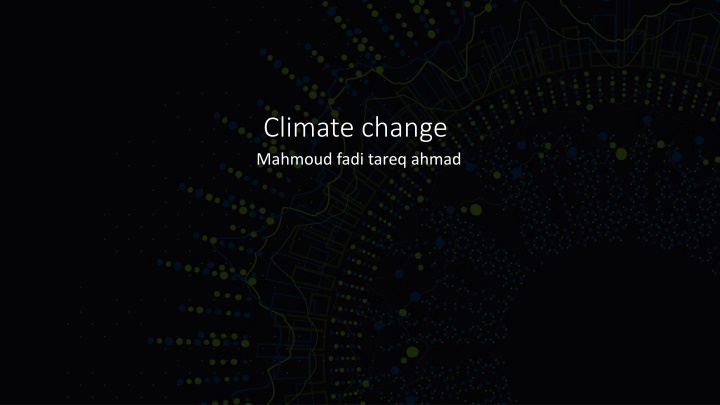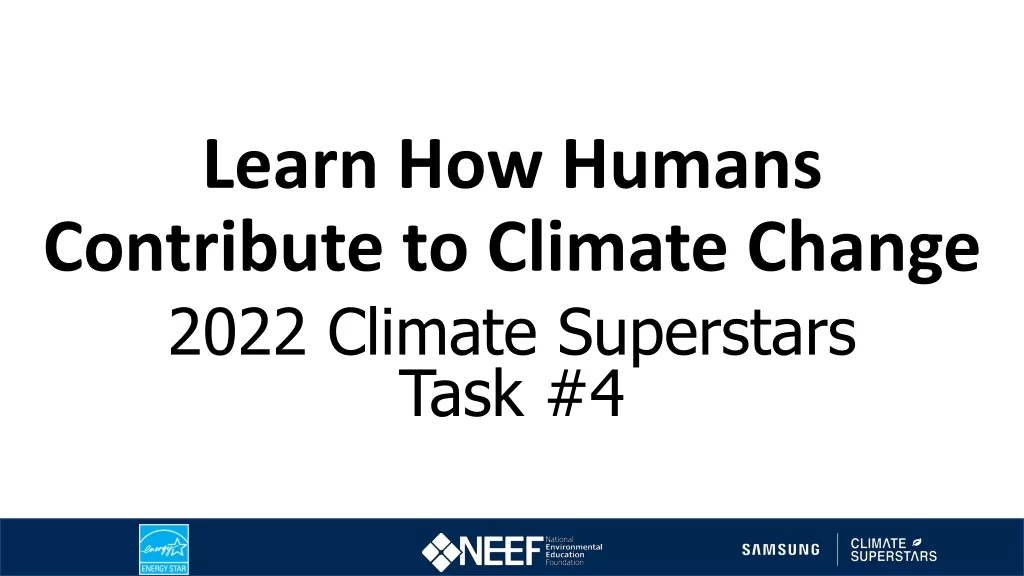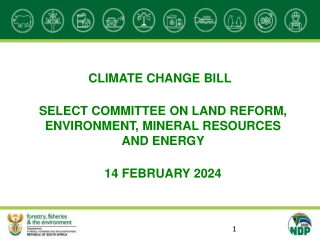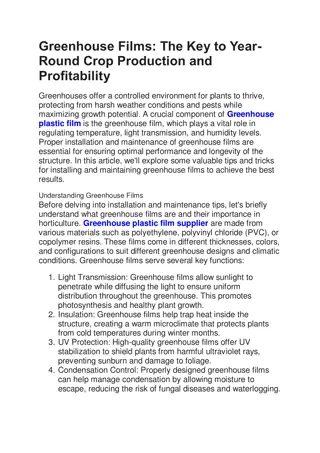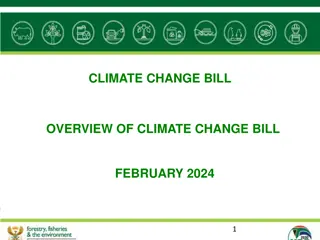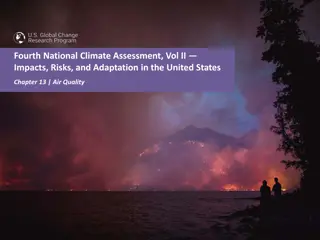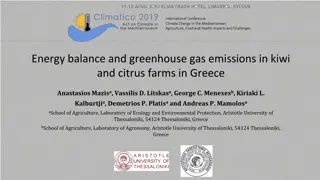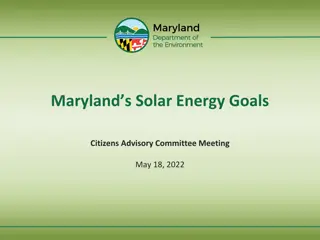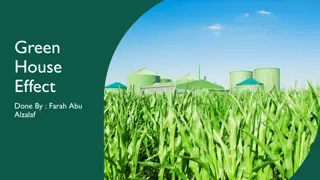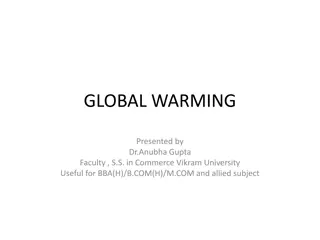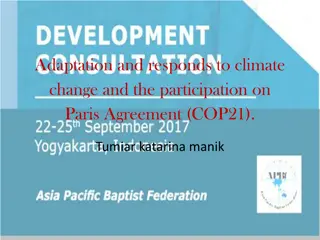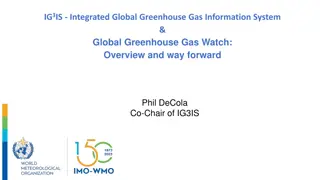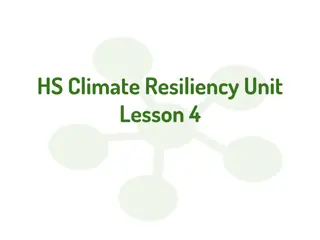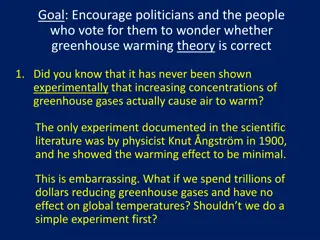Climate Change and the Greenhouse Effect
Climate change refers to long-term changes in Earth's climate patterns, such as temperature, precipitation, and wind, resulting from human activities like the release of greenhouse gases. The greenhouse effect, driven by gases like carbon dioxide and water vapor, traps heat in the atmosphere and can lead to global warming, affecting weather patterns, sea levels, and ecosystems. Controlling greenhouse gas concentrations is crucial to mitigate these effects.
Download Presentation

Please find below an Image/Link to download the presentation.
The content on the website is provided AS IS for your information and personal use only. It may not be sold, licensed, or shared on other websites without obtaining consent from the author.If you encounter any issues during the download, it is possible that the publisher has removed the file from their server.
You are allowed to download the files provided on this website for personal or commercial use, subject to the condition that they are used lawfully. All files are the property of their respective owners.
The content on the website is provided AS IS for your information and personal use only. It may not be sold, licensed, or shared on other websites without obtaining consent from the author.
E N D
Presentation Transcript
Climate change Mahmoud fadi tareq ahmad
Objectives 1.IDENTIFY WHAT IS GLOBAL WARMING Add hon
WHAT IS CLIMATE CHANGE Climate change refers to long- term changes in the Earth's climate patterns, such as temperature, precipitation, and wind, that have occurred and are likely to continue as a result of human activity, most notably the release of greenhouse gases into the atmosphere.
By which process does climate change occur?
Greenhouse effect The greenhouse effect is a process in which particular gases, known as greenhouse gases, absorb some of the sun's energy and prevent it from escaping back into space, thereby controlling the temperature of the Earth's atmosphere. The greenhouse effect requires to gasses in order to be successful the gasses are water vapor and carbon dioxide. Carbon dioxide and water vapor are the most major greenhouse gases due to their strong ability to absorb long- wave radiation, which is emitted by the Earth's surface. These gases can trap long-wave radiation in the Earth's atmosphere, preventing it from escaping into space and adding to the overall greenhouse effect. This is due to the peculiar molecular configurations of these gases, which allow them to effectively absorb and re-emit long-wave radiation. Other greenhouse gases, such as methane and nitrogen oxides, contribute to the greenhouse effect, however to a lesser extent than carbon dioxide and water vapor. The greenhouse effect is caused by the gases described above, such as carbon dioxide and water vapor. Without these gases, the Earth's atmosphere would be unable to trap any of the sun's energy and regulate temperature, rendering the planet uninhabitable to life as we know it. It is crucial to note, however, that too much of these greenhouse gases, as a result of human activities such as the use of fossil fuels, can lead to an amplified greenhouse effect, resulting in global warming and climate change. DOUBLE CHECK EVERYTHING HON
This warming may cause changes in climatic patterns, such as more frequent and severe weather events, increasing sea levels, and adjustments in ecosystems and plant and animal species distribution. As a result, controlling greenhouse gas concentrations is critical for minimizing the effects of global warming and climate change. Greenhouse effect
The causes of the increased and negative greenhouse impact The enhanced greenhouse effect is the increased warming of the Earth's atmosphere caused by larger concentrations of greenhouse gases, especially carbon dioxide, induced by human activities such as fossil fuel combustion and deforestation. Since the beginning of the industrial revolution, there has been a well-documented relationship between rising carbon dioxide concentrations in the atmosphere and average global temperatures. For the last 200 years, as people have used more and more fossil fuels, the amount of carbon dioxide in the atmosphere has increased, trapping more of the sun's energy and contributing to global warming.
Reasons for the increase carbon emissions 1. Burning coal, oil and gas: Industries use coal, oil, and gas as energy sources to run their operations and manufacture goods and services. These fossil fuels are plentiful, relatively inexpensive, and have a high energy density, making them appealing sources of energy for many industrial operations. When burning them carbon dioxide is released into the atmosphere 2. Cutting down forests: Trees supply a variety of valuable resources, including lumber for construction and paper production, and land cleared of trees can be used for farming, mining, or other economic activities. We must remember that plants (which are mostly located in forests) preform photosynthesis which is When plants, algae, and some bacteria are exposed to sunlight, a chemical process happens. Water and carbon dioxide mix during photosynthesis to generate carbohydrates (sugars) and emit oxygen. logically when there are scarce number of plants carbon dioxide is not absorbed therefore increasing co2 concentration and emission.
Advantages Advantages 1. The greenhouse effect contributes to the Earth's temperature regulation, making it hospitable for living beings. 1. More frequent and severe weather events 2. Rising sea levels 3. Shifts in ecosystems and the distribution of plant and animal species 2. Agricultural productivity may improve as a result of the greenhouse effect's warming impacts, as plants grow better at warmer temperatures. 4. Decrease in Air water quality 3. By trapping heat in the atmosphere, the greenhouse effect can help to alleviate the consequences of very cold weather in some areas. 5. Decrease in Human health
Solutions for enhanced greenhouse effect 1. Cutting down on greenhouse gas emissions: Using renewable energy sources such as solar, wind, hydropower, and geothermal. Energy efficiency in buildings, transportation, and industry is being promoted. Carbon price and emission controls are being implemented. 2. Forest conservation and restoration: Putting a stop to deforestation and encouraging reforestation and afforestation Forest conservation and management on a long-term basis 3. Technology and innovation advancement: Investing in low-carbon technology research and development Promoting the use of green technologies in industry and transportation
